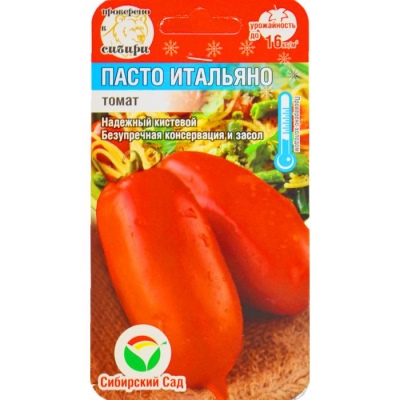
- Category: grade
- Growth type: indeterminate
- Appointment: fresh consumption, for pickling and preserving
- Ripening period: mid-early
- Ripening time, days: 100-120
- Growing conditions: for film greenhouses, for greenhouses
- Bush size: tall
- Bush height, cm: up to 200
- Ripe fruit color: deep raspberry
- Fruit shape: cylindrical
Known to many amateur gardeners and professional farmers, a selection agrofirm not so long ago pleased everyone with a novelty, presenting a new Siberian variety under a completely non-Siberian name - Pasto Italiano. Originators guarantee a stable high fruit set in any weather, an interesting berry shape, high yield and excellent taste.
Breeding history
Pasto Italiano is an exclusive selection development of the Siberian Garden agricultural company. The cultivar is a long-fruited carp culture for greenhouses and shelters. The variety is not listed in the state register today, but this does not prevent it from being popular with a large number of farmers.
Description of the variety
Tomato Pasto Italiano is a tall, indeterminate bush that grows up to a two-meter mark. On each of the plants, about 7 brushes well loaded with fruits are formed.
The main qualities of the fruit
The shape of the fruit of the Pasto Italiano variety is interesting - it is cylindrical. Tomatoes are not very large in weight - from 100 to 120 grams, but all are even, smooth, beautiful. When mature, they are colored in a deep crimson color. Many people remove them with whole brushes. Berries do not crack.
Taste characteristics
Tomatoes are good both fresh and canned. Its size is ideal for pickling. They look very nice in jars, perfectly combined in shape with peppers and cucumbers. The pulp is firm, fleshy, dense, and sugary. There are few seeds. The taste is balanced, harmonious.
Ripening and fruiting
Pasto Italiano is a medium early variety, taking into account the ripening period. It occurs 100-120 days after germination. Harvesting can be scheduled for July and August. According to some reports, the fruiting of the culture lasts until late autumn.
Yield
The yield of the variety is quite high, there is data on the collection of 16 kilograms per square meter of planting.
The timing of planting seedlings and planting in the ground
Like many other varieties, Pasto Italiano is grown in seedlings. Therefore, 50-60 days before transplanting into the ground, seeds are sown. In different regions this will happen in different ways, but the approximate dates are February-March. Accordingly, it will be possible to plant plants in a permanent growing place in April-May. The seeds of the variety germinate at a temperature of + 23-25 degrees.

Growing tomato seedlings is an extremely important process, because it largely depends on whether the gardener can harvest at all. All aspects must be taken into account, from seedbed preparation to planting in the ground.
Landing scheme
It is necessary to plant Pasto Italiano tomatoes in an amount of no more than 3 bushes per square meter of the area of the plot or greenhouse. The standard planting pattern is 40x50 cm.

Growing and care
As for the cultivation, as well as the care of the crop, they are generally the same as in the case of other Siberian varieties. Tomato Pasto Italiano must be shaped. Typically, the culture is grown in 1-2 stems. The plant also needs pinching, as well as the obligatory garter of both trunks and brushes with fruits. And also it is necessary to adhere to the schedule of watering and feeding.




A plant needs different micronutrients at each stage of growth. All fertilizers can be divided into two groups: mineral and organic. Folk remedies are often used: iodine, yeast, bird droppings, eggshells.
It is important to observe the rate and period of feeding. This also applies to folk remedies and organic fertilizers.
Disease and pest resistance
The Pasto Italiano variety is distinguished by resistance to some ailments. It is especially noted that the culture is very little affected by late blight.


Resistant to adverse weather conditions
The culture is resistant to any surprises of the weather, because it belongs to the Siberian varieties. The Pasto Italiano variety is capable of bearing fruit in almost any conditions.
Growing regions
The variety was bred specifically for the Siberian region, but the successful cultivation of Pasto Italiano tomatoes is possible in many other areas under shelters or in greenhouses.

























































































